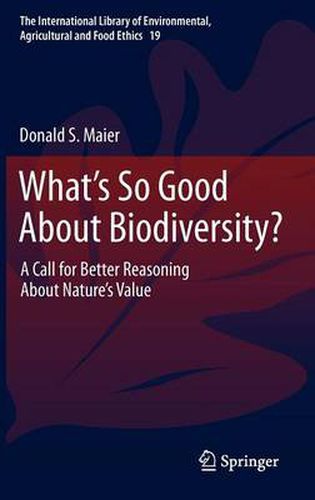Readings Newsletter
Become a Readings Member to make your shopping experience even easier.
Sign in or sign up for free!
You’re not far away from qualifying for FREE standard shipping within Australia
You’ve qualified for FREE standard shipping within Australia
The cart is loading…






This title is printed to order. This book may have been self-published. If so, we cannot guarantee the quality of the content. In the main most books will have gone through the editing process however some may not. We therefore suggest that you be aware of this before ordering this book. If in doubt check either the author or publisher’s details as we are unable to accept any returns unless they are faulty. Please contact us if you have any questions.
There has been a deluge of material on biodiversity, starting from a trickle back in the mid-1980’s. However, this book is entirely unique in its treatment of the topic. It is unique in its meticulously crafted, scientifically informed, philosophical examination of the norms and values that are at the heart of discussions about biodiversity. And it is unique in its point of view, which is the first to comprehensively challenge prevailing views about biodiversity and its value. According to those dominant views, biodiversity is an extremely good thing - so good that it has become the emblem of natural value. The book’s broader purpose is to use biodiversity as a lens through which to view the nature of natural value. It first examines, on their own terms, the arguments for why biodiversity is supposed to be a good thing. This discussion cuts a very broad and detailed swath through the scientific, economic, and environmental literature. It finds all these arguments to be seriously wanting. Worse, these arguments appear to have consequences that should dismay and perplex most environmentalists. The book then turns to a deeper analysis of these failures and suggests that they result from posing value questions from within a framework that is inappropriate for nature’s value. It concludes with a novel suggestion for framing natural value. This new proposal avoids the pitfalls of the ones that prevail in the promotion of biodiversity. And it exposes the goals of conservation biology, restoration biology, and the world’s largest conservation organizations as badly ill-conceived.
$9.00 standard shipping within Australia
FREE standard shipping within Australia for orders over $100.00
Express & International shipping calculated at checkout
This title is printed to order. This book may have been self-published. If so, we cannot guarantee the quality of the content. In the main most books will have gone through the editing process however some may not. We therefore suggest that you be aware of this before ordering this book. If in doubt check either the author or publisher’s details as we are unable to accept any returns unless they are faulty. Please contact us if you have any questions.
There has been a deluge of material on biodiversity, starting from a trickle back in the mid-1980’s. However, this book is entirely unique in its treatment of the topic. It is unique in its meticulously crafted, scientifically informed, philosophical examination of the norms and values that are at the heart of discussions about biodiversity. And it is unique in its point of view, which is the first to comprehensively challenge prevailing views about biodiversity and its value. According to those dominant views, biodiversity is an extremely good thing - so good that it has become the emblem of natural value. The book’s broader purpose is to use biodiversity as a lens through which to view the nature of natural value. It first examines, on their own terms, the arguments for why biodiversity is supposed to be a good thing. This discussion cuts a very broad and detailed swath through the scientific, economic, and environmental literature. It finds all these arguments to be seriously wanting. Worse, these arguments appear to have consequences that should dismay and perplex most environmentalists. The book then turns to a deeper analysis of these failures and suggests that they result from posing value questions from within a framework that is inappropriate for nature’s value. It concludes with a novel suggestion for framing natural value. This new proposal avoids the pitfalls of the ones that prevail in the promotion of biodiversity. And it exposes the goals of conservation biology, restoration biology, and the world’s largest conservation organizations as badly ill-conceived.